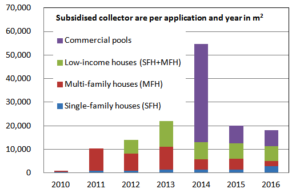California: CPUC Approves 8-Year Incentive Programme with a Budget of US$ 351 Million
February 1, 2010
On the 21st of January, the Californian Public Utilities Commission (CPUC) finally approved the “California Solar Initiative (CSI) – Thermal Program”. The eight-year programme has a budget of US$ 351 million and is thought to financially assist home owners and proprietors of commercial buildings who replace natural gas or electric geysers with solar water heaters (see the final decision of CPUC attached).
“We have a pretty good programme and they increased the maximum amount of incentives for both sectors, residential and commercial, in the last round,” comments Ed Murray, President of the Californian system supplier Aztec Solar Inc and Treasurer of the California Solar Energy Industry Association (Calseia). He was part of a group of about 25 solar thermal professionals who visited the CPUC at the 23rd of December, in order to understand the reasons behind the latest delay.
The CPUC did not approve the CSI – Thermal Program on the 18th of December 2009 (see http://www.solarthermalworld.org/node/952) as had been planned beforehand. “There were still some doubts about the cost-effectiveness of solar thermal technology. But this very day, we could convince the commissioners to vote for the programme,” says Murray. In addition, the cap for commercial systems has been increased from US$ 200,000 to 500,000 if replacing natural gas systems and from US$ 100,000 to 200,000 if replacing electric systems (for further details, see the database of incentive programmes).
“I am very excited about the programme,” says Les Nelson, Chairman of the Solar Thermal Division within the Solar Energy Industries Association (SEIA). “The market for solar thermal water and space heating in California has been very small since the mid-1980’s. The introduction of this programme will start a new era.”
The drafting of the programme started in 2007 under the name 200,000-roof-programme, but now it is called CSI – Thermal Program. Why is that so?
“Water heating in California uses very inexpensive natural gas, therefore the cost-effectiveness for commercial solar thermal applications was easier to demonstrate than for residential systems,” answers Nelson. The CPUC finally decided to use only 40 % of the total budget for the residential sector, whereas 60 % will be spent on large solar thermal systems for multi-family houses and commercial applications. This will actually result in less roofs, albeit not risking the target of replacing 484 million therms and 276 million kWh of electricity by 2017.
And, the programme has a few more features deemed innovative:
First: “We’ve structured the incentives so they are based on the performance of solar water heating systems, in order to promote the adoption of high-performing systems,“ CPUC President Michael R. Peevey said in a press release issued by the CPUC at the 21st of January.
Second: Incentives are highest at the beginning of the programme and are going to decrease in four stages over time. As for applications replacing natural gas systems, incentives range from 12.82 US$/therm in stage one to 4.70 US$/therm in stage four – both for residential and commercial applications. This equals average residential incentives for a solar water heater from US$ 1,500 (first stage) to US$ 550 (fourth stage). The incentives for applications replacing electric geysers are notably lower: starting at 0.37 US$/kWh in stage one (with an incentive for an average residential home of US$1,010) and ending with 0.14 US$/kWh in stage four (with an incentive for an average residential home of US$ 380). Unfortunately, households or commercial users heating with propane are not eligible for the programme, even if they consume electricity by using one of the above-mentioned methods.
The 1st of May will be the official starting date of the programme for accepting residential applications. As for multi-family homes and commercial buildings, the kick-off date is the 1st of June. Applications for solar thermal systems installed after the 15th of July 2009 will be accepted. The CPUC will finalize the programme’s handbooks in the coming month and the industry will train their sales people simultaneously, so that they are able to explain the benefits of the programme and the solar thermal technology to consumers.
More Information:
http://www.cpuc.ca.gov
California Public Utilities Commission
505 Van Ness Ave., San Francisco
Terrie Prosper,
Tel: +1 415 703 2160.
Mail: tdp@cpuc.ca.gov
Text was written in cooperation with communication specialist Hanna Schober based in South Africa. Schober@solrico.com

